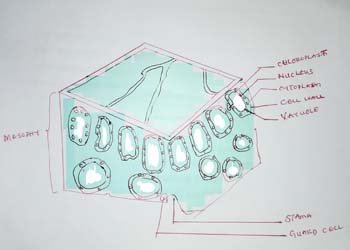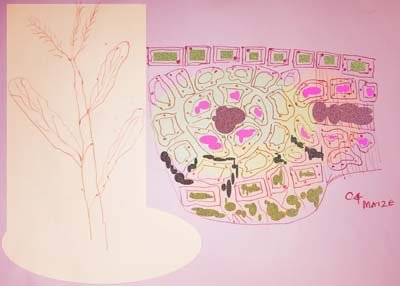SUPPORTING TISSUES IN PLANTS; FUNCTIONS AND TYPES
Good day steemians, It's my pleasure to say a big thanks for glancing through my last post
I will be talking about the functions and types of supporting tissues in plant in this post.
I travelled yesterday to next town and I observed that most of the plants I saw along the road were almost dried off because of lack of adequate rainfall in that area. Plants lost most of the nutrients that suppose to utilized for their growth in the dry season as a result of lack of water to sustain their growth. Rainfall plays an important role in plants to manufacture their food and without water, no life can survive on earth.

Image created by me
Plants do not move around in search of food like animals do and due to their nature, they do not need a highly developed skeletal system like animals. However, plants do need supporting tissues to remain upright, spread out their branches and hold their leaves in position for trapping sunlight. The important types of supporting tissues in plants are, turgid parenchyma(unspecialized plant cells), collenchymas, sclerenchyma, and xylem (wood).
Location and Arrangement of Supporting Tissues
Most terrestrial plants have an aerial shoot system and an underground root system. The roots are surrounded by soil which they grip, and which in turn presses on them. The movements of the shoot also exert a pulling force on the roots. The upright aerial stems are subjected to the bending force of the winds. As a result, the internal structure of stems and roots are designed to withstand bending and pulling forces.
Internal Structure of Herbaceous Roots consists of an outer cylinder and an inner central cylinder which is also referred to as a stele. A transverse section of the root shows the following arrangement of tissues from the circumference to the centre; piliferous layer, cortex, including the endodermis, all these are the outer layer. Inner cylinder or settle are comprised of all these, pericycle, vascular tissue and pith.
The outer cylinder consists of a wide zone of loosely packed, thin-walled parenchyma bound on the outside by a sing-cell thick piliferous layer. Root hairs arise from young cells of the piliferous layer. The endodermis is the innermost layer of the cortex. It is made up of a single-cell-thick layer of barrel-shaped cells. Each cell is encircled by a thick waxy band. The stele consists of vascular tissue, made up of alternate phloem and xylem bundles arranged in a ring. Usually, there are more vascular bundles in a monocotyledonous root than a dicotyledonous one.
The pericycle which bounds the vascular tissue on the outer side is a cell or two-cell thick layer of thin-walled cells. The pith is large in monocotyledonous roots and composed of thin-walled parenchyma. In most dicotyledonous roots, the xylem fills up the centre of the stele, forming a centrally supporting column. The main supporting tissues in roots are xylem and the turgid parenchyma which makes up the cortex.
NOTE: Cambium, a meristematic tissue which gives rise to secondary growth, appears in older dicotyledonous roots but is completely absent in monocotyledonous.

Image created by me
Internal Structure of Herbaceous Stem
A stem has more supporting tissues than a root. The arrangement of tissues in dicotyledonous stems differs markedly from that in the monocotyledonous stem. The following shows the arrangement of tissues from the circumference to the centre; epidermis, cortex, including the endodermis, all these are outer cylinder and pericycle, vascular bundles, pith and medullary rays, all these are inner cylinder or stele.
The epidermis is single-cell thick and made up of closely packed rectangular cells. The cells are thickened on the outer walls by cutin, waterproof materials which form an outer skin or cuticle. Stomata and lenticles are found between the epidermal cells. The cortex is made up of collenchyma. The collenchyma forms a strengthening hollow cylinder down the length of the stem.
The innermost layer of the cortex is bound by the endodermis. The pericycle, found just above the vascular boundless, is composed mainly of sclerenchyma. It is usually several cells thick and forms solid strengthening strands that run down the length of the stem. The vascular bundles are arranged in a ring within the pericycle. Each bundle is composed of phloem, cambium, and xylem.
Note: Ground tissue includes all plant tissues, except the dermal and vascular tissues. Thus, the cortex, pith and medullary rays are part of the ground tissue. In monocotyledons, the cambium is absent in the vascular bundle.
Leaves have a large surface and carry out photosynthesis. In cotyledon network of vascular tissue (veins) support leaf blade from the forces of the wind monocotyledons, the vascular tissue ai arrange in a parallel pattern.

By Kelvinsong - Own work, CC BY-SA 3.0,Plant cell types.svg
Main Feature of Supporting Tissues
Turgid parenchyma is a tissue made up of living unspecialized plant cells that are roughly spherical in shape, the parenchymatous cell has a thin but fairly rigid cell wall composed mainly of cellulose, and a large vacuole containing cell sap. Cell sap is a concentrated solution and has a high osmotic pressure.
Water (absorbed by the roots) enters the cell and passes into the vacuole by osmotic. The cell vacuole increases in volume causing the cytoplasm to press against the cell wall. The cell wall only expands slightly and resists the internal water pressure, this is called turgor pressure. Eventually, turgor pressure builds high enough to stop the flow of water into the cell (although the cell sap may still be more concentrated than the medium outside the cell), such a cell is said to be fully turgid.
Turgid parenchymatous cells press against one another and become tightly packed, providing support in the organs where they are found. In herbaceous plants, turgid parenchyma provides the main support.
Collenchyma tissue consists of living cells that are thickened at the corners by the deposition of extra cellulose, to provide support and mechanical strength. They are usually polygonal elongated cells with tapering ends.
Collenchyma is found in the primary tissues of the plant, therefore, an important supporting tissue in young plants, such as leaves, in secondary growth does not occur. In these plants, it supplements the strengthening effects of the turgid parenchyma. It also found below the epidermis in stems and in the midrib of leaves.
Sclerenchyma tissue is composed of two types of cells, fibres and sclereids. Both are dead cells in which the cell walls are heavily thickened with deposits of lignin, a hard substance that provides mechanical strength. (A dead cell has a cell wall enclosing a space or lumen instead of protoplasm).
Sclereids or stone cells are heavily lignified cells which are roughly spherical and slightly elongated. They are scattered singly, in groups or in solid layers in almost all parts of the plant, especially in the cortex, pith, phloem, fruits and seed coat.
Xylem is the water-conducting tissue which also has a strengthening function, especially in plants that undergo secondary growth. Four types of cells make up the xylem tissue; the tracheids, vessels, fibres, and parenchyma. Of these, the first three are lignified and so provide mechanical support.
CONCLUSION
The plant does not need a highly developed skeletal system like animals and also, do not have to move from one place to another before obtaining food but spread out their branches and hold their leaves in the positions for trapping sunlight for manufacturing its food. The roots are surrounded by soil which they grip, and which in turn presses on them.
The movements of the shoot also exert a pulling force on the roots. The upright aerial stems are subjected to the bending force of the winds. So, water is essential in the life of living things which can serve as the nuorishement in the process of the growth.
References
Good work, well done.
@semilore, I experienced the same issue some weeks ago when I went to my farm to check my cassava tuber being planted and then noticed that, the cassava tuber is not germinating as expected due to lack or inadequate rainfall since three weeks ago.
Hi @semilore!
Your post was upvoted by utopian.io in cooperation with steemstem - supporting knowledge, innovation and technological advancement on the Steem Blockchain.
Contribute to Open Source with utopian.io
Learn how to contribute on our website and join the new open source economy.
Want to chat? Join the Utopian Community on Discord https://discord.gg/h52nFrV
@semilore this is a very good and informative post .
Please keep it up. Plant have no hands and legs but yet they survive even the worst weather conditions because of their make up. Thanks to the several tissue providing support for them.
One thing that got me attracted to this article are you images... Simple and illustrative @semilore